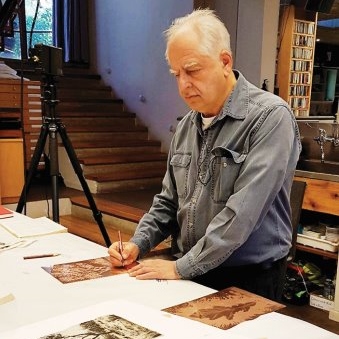
News

Unbearable rightness of uncertainty underpins Kentridge’s art
MIRAH LANGER
“It’s a bit of a matzah pudding,” quipped Kentridge after a video clip of one of this theatre-making processes was shown at an event at the University of Johannesburg in Auckland Park last week.
However, he said, in collaborative work, “making space for not knowing what we are doing is the vital part. There is an extraordinary energy that comes as discoveries are made. The performers are also part of the making and discovery of the performance.”
Kentridge made these remarks in conversation with Kim Berman, who heads Artist Proof Studio, a community printmaking centre. They spoke about the wide-ranging ways in which Kentridge has adopted collaboration and co-creation as a methodology in his work, which ranges from print-making to theatre productions.
Kentridge said his first experience of collaborative theatre work shaped what he would come to embrace and refine in his own projects.
During the 1970s and 1980s in South Africa, the “most interesting theatrical pieces were made through an improvisational, collaborative” process, he said, citing examples of the plays produced by Athol Fugard, John Kani, and Winston Ntshona.
“There was a way in which through collaboration, different parts of different communities would actually listen to each other and hear each other in a way that is very different from an author writing a script on their own.”
Kentridge’s initial foray into this field was with the Junction Avenue Theatre Company in Johannesburg, which was also working to produce protest theatre during the apartheid era. “[The company] had a kind of radical democratic idea that everybody’s voice was equally valid. It was an interesting lesson in democracy because all it really meant was that whoever was the most strident or the most self-serving, [got their way].
“I was always uncertain about how things should be done, or how we should tackle the scene, and there were certain people in the group who were very certain about exactly how to do so. I found I would always give in to that certainty. But I realised afterwards that if I hung onto my uncertainty, I would have had a better result.”
As such, when he returned to collaborative work in theatre years later, he established two ground rules. “One was to structure a space for uncertainty, for doubt, and for not knowing what we were doing into the very technique and strategies used.
“Second, it was to say that even though there was this space, it wasn’t a radical democracy. In the end, I would be the director and decision maker. The studio has to be a safe space for stupidity, for giving an impulse the benefit of the doubt, for allowing a kind of free association.”
While the successful outcome of this process was never guaranteed, it did allow one to get to the point of realising the ultimate potential of an idea. On a deeper level, he said working with uncertainty in art also carried an underlying political resonance.
Kentridge said he discovered early on that he wasn’t suited to direct political involvement as a “committee person” or community activist.
“I tried doing that, but I realised that every time I would give in to the person that was louder, or to the person that would go to one more meeting which I couldn’t get to,” he said. “In the end, the most I could offer was the example of what it was to be in the studio; the duty one owes to one’s metier.
“There is a politics to it, but it’s a politics of saying that politics is made up of ambiguity, contradiction, and uncertainty. In the art which shows [these elements], there is a demonstration of how the world works and operates.”
Kentridge spoke about his upcoming new theatrical project, the opera Waiting for the Sibyl, which will premiere in Rome in September. The concept springboards from that of the “sibyls”, the ancient Greek oracles, and explores ideas of fate.
A clip Kentridge screened of the work in progress showed input being offered from various collaborators including choral directors, actors, dancers, musicians, film makers, and editors, as well as lighting and costume designers.
Kentridge also spoke about his Centre For the Less Good Idea, an organisation which brings together interdisciplinary arts practitioner to build collaborative work. He said that the name was a twist on a Tswana proverb that declares, “If the clever doctor can’t cure you, find the less clever doctor.”
Kentridge said that while the centre didn’t allow “a free for all”, it did ensure that artists had “an openness within the heart” of their work.
The Johannesburg-born and based artist discussed his process of printmaking, saying it had links to theatre-making. “There are points of overlap. In each case, there is a kind of transformation that is going to happen between the first idea, and how it arises.”
Printmaking is always “a negotiation between the image and this form of print making that is a kind of a dance. Having anticipated the way it will be printed, the actual print is always a surprise.
“You have a sense of how it looks on the plate. It comes out on the paper, and usually it is a disappointment,” said the artist who has been recognised with an Order of Arts and Letters from France, the Carnegie Prize, and various honorary doctorates, with a cheeky grin.




